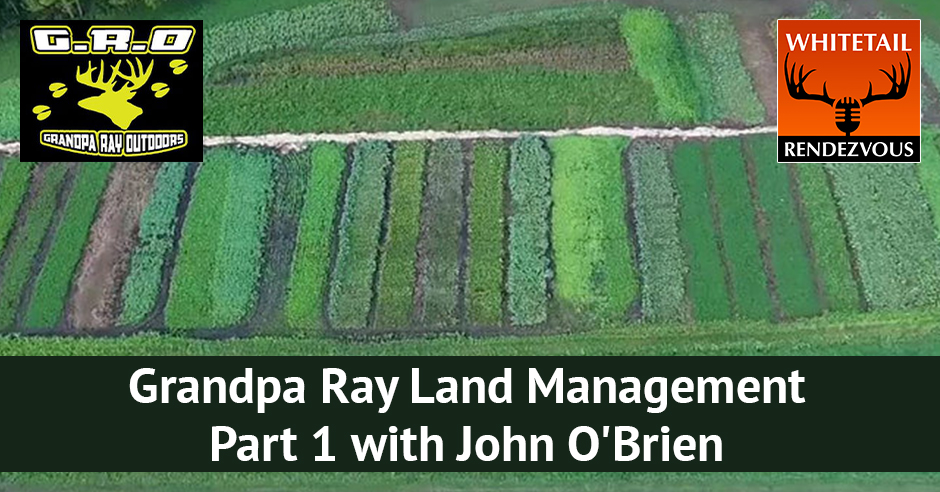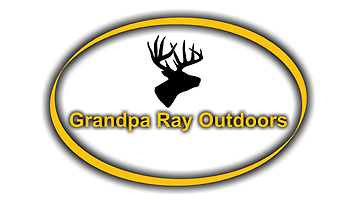
In a special spring series, host Bruce Hutcheon invites a couple of his close friends and business people that are in the outdoor industry, land management, and food plots. On today’s show, he is joined by John O’Brien, the Owner, Operator, and Chief Seed Planner at Grandpa Ray Outdoors. John is an agronomist and food planner who has been in this business for a long time. John defines land management and what it entails, and clarifies whether it is for everyone or not. He also sets the expectations for anyone looking into land management and differentiates land management versus food plotting.
—
Listen to the podcast here:
Grandpa Ray Land Management Part 1 with John O’Brien
We’re with a special spring series. I invited a couple of my close friends and business people that are in the outdoor industry, land management and food plots. One of those guys has been a partner all the way along this ride for Whitetail Rendezvous. John O’Brien is the Owner, Operator and Chief Seed Planner at Grandpa Ray Outdoors. John, welcome.
Thanks, Bruce, as always.
John’s got many years as an agronomist. He is a food planner. He’s been in this business for a long time and then you’ve heard from a couple of people. Eric Fitzgerald also has been in the business for a long time as an agronomist. One thing that John does, he understands the process. He understands what happens in the first inch of soil. He understands the importance of moisture, sunlight and all that. He’s helped thousands of people earn a living, grown cows and growing crops. With all that, I asked John to be part of the special spring series. The spring series is land management and food plots. Land management is a three-part series. We’re going to talk about, one, what is land management? Two, is land management for everyone? Three, the expectations you should have if you would call up John and talk to him at Grandpa Ray about land management. He’s going to lay that out. Those are the three things we’re going to jump right in. John, what is land management versus food plots? Everybody’s got a sign out saying, “I’m a land manager.” Help me out here.
You’ve seen a little bit of shift in the industry. You’re going to continue to see a shift towards people spending money on consultants, land managers trying to dial in. You hear in your own particular wildlife program a little better. What is land management? That’s a great question. Everybody would have a different interpretation. Everybody has a different expectation. Some people are also more focused on the short-term. My little words that I want to throw at you and others out there is short-term planning is great. Long-term, having a vision and trying to create a sustainable property, a sustainable program is the way to start. Sacrifice sometimes in the short-term because all of us want to have not just instant success, short-term success. I think we want to enjoy the fruits of our labor not just this year, but many years into the future.
It’s easy to make mistakes, but it’s hard to make up for those. Share on XJohn, you see it, I see it all over social media, land management. I think you said it well. Do you have just, “I’m leasing land for a few years, what can I do quick down and dirty?” “I’ve got a five-year lease on this thing or the family owns this farm.” What do we need to do? I know on our farm along the Baraboo River, we did some timber cutting up on a ridge that hadn’t been touched in how long, and it’s all climax forest and there was no undergrowth. Now we’re going to have a jungle fest. We’ll work on that. Having said that, a lot of people are thinking, “I’ve got to do better for my land. I can’t just go sit in the concussion stand and hope a deer comes by and that stand was put up several years ago.” How does all that relate to land management?
When anybody comes to me at shows and we get into this topic, there are a series of questions that need to be asked to be able to give anybody a great answer versus just an answer. Whether you have a situation like yours or maybe you have a three-year, five-year lease, that will affect your plan if you don’t have a commitment where what you’re doing now could be utilized for five years down the line. It’s different if the guy owns the land and he’s planning on owning the land for a number of years. No matter what the situation is, no matter if you have a lease or ownership, no matter if you have 15 acres or 500 acres, they’re still the same basic concepts. The first thing that I want to throw at is besides having a vision, besides having a plan, don’t rush to start hacking trees. Don’t rush to do too much too fast because so many people will make mistakes. It’s easy to make mistakes and it’s hard to make up for those.
I will recommend people surrounding yourself with a good team of land managers. For example, my focus and my specialty is soil and seed. There are guys like Art Helin that I believe you’ve actually interviewed a number of times. His specialty is timber stand improvement. There are other guys out there that specialize in water. There’s no one expert in the industry that can be an expert at all phases of property and land management. Guys like myself work with guys like Zach Hauser on the water and guys like Art Helin. There might be three, four different sets of eyes looking at one property, working as a team with a long-term goal in mind. I believe that’s a sound approach and something more people should consider is making it a team approach to long-term sustainability.
You mentioned timber, water and cover. Those are the three critical things that the deer need to have. If you don’t have those, you’re not going to keep the deer. They might come through but you’re not going to keep the deer. When somebody calls you up, are they calling you up specifically on the food plot? Are you walking the land and telling them how to lay out everything as far as food plots? Do you yourself just bring in Art and say, “Take a look at this timber.” How do you work there at Grandpa Ray?
There are cases where they might have already had other experts like Art Helin, guys like Jim Ward, Tony LaPratt, other people that might have already been on the property. People get a hold of me because they’ve already got their property laid out. Maybe their stand locations are laid out and now they really want to dial in the food plots. There are other cases too where maybe I’m the first guy on the property. Even though I’m pretty good with helping people layout, “This is a great spot for putting your stand. Here’s a spot that’d probably be ideal for putting water. Here are some habitat areas that you should look at doing.” There are all different situations. For me there’s no right or wrong answer as far as should I be on the property first, should I be out there after your property has already been laid out? What I do if somebody gets a hold of me, I do ask those questions, “Has anybody been there before?” If there has, “Did the guy do a bunch of hinge-cutting? Did he do a bunch of stump-cutting? What has been done on your property?” We’ll go from there based on what a guy wants from me.

What they’ll get from me is a whole different perspective than what they’re going to get from most other people in the industry because I’m not just focused on, “Let’s plant something this year. Here are some of the better things you could plant this year.” I’m looking at their specific goals. Factors like how many deer are on your property? What are the neighbors doing? A whole list of questions that will affect all these other factors as far as where do you cut trees if you cut trees? Where do you put water if you need to put the water? Where to put food plots? It isn’t just, “What are you looking to do on your property?” Your neighbors can have a huge influence on what we’re going to decide to do. When I say we, it could be me an individual, it could be me and other team members that are working with the client on their property. Those are things that most people don’t think about.
I’m thinking back to a couple of other guys and you’re bringing a little different set of eyes, if you will, to the whole process. That’s what this thing is. I’ve come to realize that the whole process, there’s no right way or wrong way, but it’s a process. That if you want to have the deer consistently and grow the deer and have it on a long-term basis, you need to change it up. Let’s talk about land management. You are changing it up. We’ve got stands on our farm several years old. I’ve lobbied a long time all the wooden stands. You don’t need to come down and say, “Nobody uses it anymore but I still think that has come down aesthetically.” You need to change up your stand and that’s part of land management. You do crop rotation, but you should think about a stand location because things change. What would change on land? I know Grandpa Ray farm. You’ve got some stands that had been there a long time. Why do you change up those stand placements?
Important Links:
- Grandpa Ray Outdoors
- Art Helin – past episode
